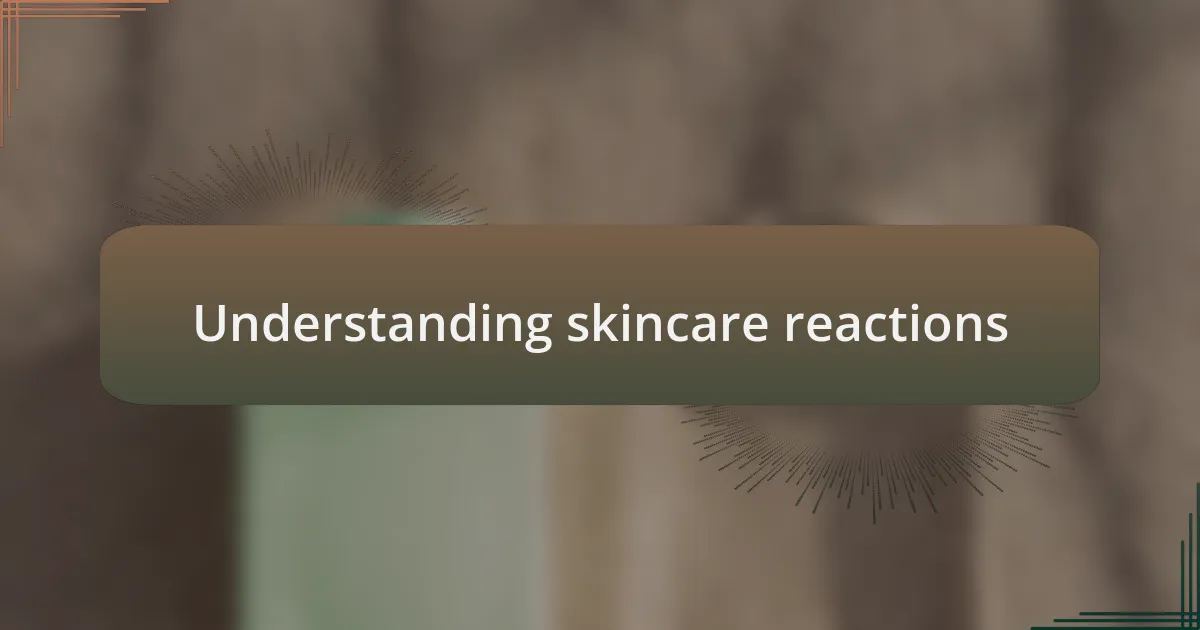Key takeaways:
- Skincare reactions often arise from ingredient sensitivities, allergies, or environmental factors, emphasizing the need to understand your skin’s unique needs.
- Implementing a patch test for new products and maintaining a minimal skincare routine can significantly reduce the risk of irritation.
- Holistic care is essential; factors such as hydration, diet, and overall well-being play a crucial role in skin health and recovery.

Understanding skincare reactions
Skincare reactions happen for various reasons, often stemming from an ingredient that doesn’t agree with your skin. I once applied a new moisturizer that promised hydration but left my face feeling hot and irritated—an uncomfortable reminder that not all products are created equal. Have you ever experienced that sinking feeling when you realize a product isn’t right for you?
It’s essential to understand your skin’s unique needs and sensitivities. When I started my skincare journey, I was overwhelmed by the variety of formulations available, and I sometimes overlooked my skin’s specific signals. This taught me a crucial lesson: listening to your skin is just as vital as choosing the right products.
Many factors can contribute to a negative reaction, including allergies, irritants, and even hormonal changes. I recall a time when a change in my diet coincided with a breakout, prompting me to rethink not just my skincare but my lifestyle as a whole. How often do we consider the broader influences on our skin health? Understanding these connections can be transformative in preventing future reactions.

Common causes of skincare reactions
When it comes to skincare reactions, one of the most common culprits is allergies to specific ingredients. I vividly remember trying a popular serum that was all the rage. A few hours after applying it, my skin became red and swollen, and I was left wondering what I had done wrong. It dawned on me that even well-received products can still trigger adverse reactions in those with sensitivities. Have you ever had that moment of revelation when something seemingly harmless turns out to be anything but?
Another frequent source of irritation arises from harsh ingredients that, while effective for some, can disrupt the delicate balance of others. A few months ago, I switched to an exfoliating cleanser, thinking it would give my skin a fresh glow. Instead, it left my face feeling raw and peeling, reminding me that gentleness is key. It’s a lesson I wish I had learned sooner: not every product is for every skin type. Does this resonate with your own experiences of trial and error?
Lastly, environmental factors can play a significant role in how our skin reacts. During a particularly stressful week at work, I noticed my skin breaking out in hives. It wasn’t just the products; it was the combination of stress, lack of sleep, and changes in humidity that pushed my skin over the edge. This made me realize that sometimes, skincare isn’t solely about what we put on our skin but also how we care for ourselves holistically. How often do we pause to consider the bigger picture in our skincare routine?

Steps I took to recover
To begin my recovery, I promptly removed the offending product from my skincare routine. I felt an immediate sense of relief just knowing I had taken that step. It’s incredible how that simple action can provide peace of mind during a chaotic moment in your skincare journey.
Next, I turned to soothing remedies that I had on hand, like aloe vera and calendula oil. The calming sensation as I applied these products was not just physical; it felt like a balm for my anxious mind as well. Have you ever found that the right remedy can help you feel more in control during a skincare crisis?
Hydration also became my priority. I made sure to drink plenty of water and use a gentle, fragrance-free moisturizer to rebuild my skin’s barrier. It’s fascinating how nourishing your body inside and out can speed up recovery. After all, caring for our skin often requires a holistic approach, one that acknowledges the connection between our overall well-being and skin health.

Tips for preventing future reactions
When it comes to preventing future reactions, it’s crucial to patch test new products before fully incorporating them into my routine. I learned this the hard way after a particularly harsh breakout. Now, I take the time to apply a small amount on my wrist or behind my ear and wait 24 hours. It’s a simple practice that can save you a lot of hassle later on.
Another tip I’ve found invaluable is to keep my skincare routine minimal. During my recovery, I realized that the fewer products I use, the less chance there is for irritation. I now stick to a core group of tried-and-true favorites that nourish my skin without overwhelming it. Have you considered how simplifying your routine might give your skin the space it needs to flourish?
Finally, I make it a point to read labels closely for potential irritants. Ingredients like alcohol or heavy fragrances, which I once ignored, can wreak havoc on sensitive skin. Now, before I buy anything, I think back to my experiences with bad reactions. It’s empowering to know that this diligence can lead me to safer choices and help me avoid unwanted surprises in the future.